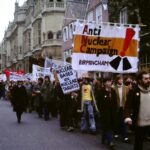Driving through the serene semi-arid desert landscape of southeastern Washington State, you might be surprised to learn of your proximity to the most contaminated nuclear site in the United States. At the Hanford Site, 56 million gallons of radioactive waste linger in 177 tanks, many of which are being utilized well beyond their intended lifespan. This decommissioned nuclear site produced plutonium for more than two-thirds of the US nuclear arsenal. And the consequences were longstanding. “Every bomb we produced created massive amounts of contamination at Hanford,” said Rep. Gerry Pollet, of the Washington House of Representatives and executive director of Heart of America Northwest.
The Holistic Negotiations Agreement, which was made public in April 2024, outlines a plan for cleaning up the tank waste. The agreement provides a path forward “for the next 15-20 years to treat millions of gallons of radioactive and chemical waste for safe disposal that protects Hanford workers, the public and the environment,” according to Geoff Tyee, a spokesperson for the Department of Energy at Hanford. “The agreement will get more tank waste retrieved, treated and safely disposed of on schedule,” he added. Conversely, Hanford cleanup advocates like Pollet are not so quick to celebrate and have expressed concerns that many of the timelines are not likely to be met or are too little, too late. What the extensive process reveals is the nuclear half-life, so to speak — the long-term repercussions at home of America’s wars abroad.
The Holistic Negotiations Agreement
Initially signed in 1989 by the Washington State Department of Ecology, the EPA and the US Department of Energy (DOE), the Tri-Party Agreement (TPA) details how the state and federal governments will clean up the hazardous and radioactive nuclear waste at the Hanford Site. Since 1989, the TPA has been revised and updated to adjust the cleanup schedules within the document when additional information and technology become available and cleanup progresses, but also when delays and setbacks arise. The original TPA included less than 200 enforceable milestones and target dates, but it has now ballooned to include more than 1,500 milestones and target dates.
In 2020, a series of mediated and private negotiations, known as Holistic Negotiations, commenced with the goal of re-evaluating and adjusting the cleanup schedules outlined in the TPA and the Washington v. Granholm consent decree, the latter of which resulted from litigation against the DOE by the Washington State Department of Ecology. After four years of negotiations on how to proceed with the herculean task of cleaning up the nuclear waste at the Hanford Site, the proposed amendments were announced in the Holistic Negotiations Agreement. According to Tyree, this new agreement “sets a realistic and achievable course for continuing cleanup of millions of gallons of tank waste at the Hanford Site, and that includes both funding and resources.” Importantly, this updated plan takes into consideration the fiscal constraints for cleanup, Tyree explained.
The main stipulations of the Holistic Negotiations Agreement include adhering to the existing timeframes for the vitrification of nuclear waste, building additional storage for tank waste, removing waste from the high-priority 200 West Area of the site, and exploring new and innovative waste removal technologies. Vitrification, a process that integrates nuclear waste into molten glass, is a promising option for safe long-term storage. Despite its potential, the Hanford Vitrification Plant has been plagued by delays and setbacks for decades. Pollet expressed skepticism regarding the likelihood of the Hanford Site meeting deadlines for vitrifying nuclear waste, particularly high-level waste.
Delays have been announced even after the Holistic Negotiations Agreement was made public in April. In late June, the Department of Energy requested a four-month extension from Aug. 1 to Nov. 29, 2024, for the “cold commissioning” of the vitrification facility, which will involve initially running tests using nonradioactive chemicals ahead of the 2025 target date for incorporating radioactive waste. This is one extension of many since construction of the facility commenced in the early 2000s.
According to the Washington State Department of Ecology, two nuclear waste storage tanks, B-109 and T-111, are actively leaking. While the Holistic Negotiations Agreement outlines a plan to address the current leaks and prevent additional leaks before they occur, advocacy groups like Heart of America Northwest are concerned that the agreement doesn’t act quickly enough. B-109 alone is leaking an estimated 1.5 to 3.5 gallons per day, or 560 to 1,275 gallons per year. On the high end of the estimate, that’s enough to fill half of a Starbucks Venti cup every 30 minutes, Pollet explained.
But the Washington State Department of Ecology estimates that it will take at least 25 years for the leaking waste from B-109 to reach groundwater, and up to 70 years for the leaking waste from T-111 to reach groundwater. “Any leak is an environmental concern that we want to make sure gets addressed, but the groundwater table sits roughly 200 to 300 feet beneath the surface of the soil at the Hanford Site,” said Ryan Miller, a spokesperson for Washington’s Department of Ecology. “It takes quite a bit of time for contamination to migrate down that far.”
Community Impact
Established in the name of national defense, the lasting legacy of Hanford continues to negatively impact those living within the borders of the United States. Though plutonium production officially ceased in the late 1980s, the Hanford Site still poses a threat to the surrounding communities and has had disproportionate effects on BIPOC communities. As such, mistrust of the government regarding potential public safety hazards at Hanford is nothing new, nor are concerns unfounded.
The leaking storage tanks are not the first instance of radioactive contamination threatening nearby communities. The Green Run experiment of 1949 was the largest single and most well-known release of radioactive particles at Hanford. 8,000 curies of radioactive iodine-131 were released into the air, contaminating soil, water, plants, and crops within hundreds of miles of the Hanford Site. Between 1944 and 1972, 739,000 curies of radioactive iodine-131 were released at Hanford. These releases, some negligent and others intentional, have led to serious ongoing health problems even decades after. High rates of cancer, thyroid diseases, infertility, and lymphatic illness occur in those who live downwind of the Hanford Site, who have become known as “downwinders.”
The Contamination of Sacred Land
Similar to other sites for the Manhattan Project, notably the Los Alamos National Laboratory where Hanford-made plutonium was used to deploy the Trinity Test, the land upon which the Hanford Site was built is sacred to Indigenous communities.
The Confederated Tribes and Bands of the Yakama Nation, the Confederated Tribes of the Umatilla Indian Reservation, Nez Perce Tribe, and the Wanapum Band, have used this land for fishing, hunting, and gathering for generations. “The land has been devastated quite a bit from the Manhattan Project,” said Trina Sherwood, a cultural specialist for the Yakama Nation’s Environmental Restoration and Waste Management Program. “It can never be returned to the way it was.”
The treaties of the Walla Walla Council of 1855 and Executive Order 13007 ensure access for Tribal Members to hunt, fish, and gather on their ancestral lands. Though the existence of the Hanford Site has significantly limited Tribal access to these lands in violation of the treaty, the practices of hunting, fishing, and digging roots for ceremonial purposes and food continue to have deep cultural significance for the Yakama Nation, according to Sherwood and her colleagues Rose Ferri and Laurene Contreras. Now, these practices bring the risk of exposure to radioactive contamination. “If you are a tribal member and you are out digging roots, you have got basically three pathways of contamination,” said Rose Ferri, a project tracking resource analyst for the Yakama Nation. These pathways include dermal, from skin to soil contact, inhalation, from disturbing polluted soil, and ingestion, from consuming contaminated plants and roots, Ferri explained.
Tribal leadership was excluded from the recent negotiations to update the milestones and target dates of the Hanford Site cleanup. Representatives from the Yakama Nation declined to comment for this article on their exclusion from the Holistic Negotiations. “The negotiations were done under a confidentiality mediation agreement that basically precluded the agencies from being able to share details of the negotiations until an agreement was reached,” Miller explained. “The agencies will consult with the area Tribes upon request, and we will consider what we hear during those meetings along with public comments when making decisions on proposed changes to cleanup agreements,” Tyree added. Tribal Members are able to take part in the public comment period along with other community members, which closes on September 1, 2024. The proposed amendments to the TPA and the Washington v. Energy consent decree will not become official until the end of the public comment period.
Hanford and the Working Class
High rates of cancer and other illnesses in downwinder communities are well-documented. What is less understood is the disproportionate impact of radioactive contamination on the large population of migrant workers who have farmed the fertile land surrounding the Hanford Site since the early 1900s. Given their work practices they are susceptible to higher rates of exposure due to long hours of outdoor work, direct contact with soil, and proximity to contaminated irrigation water.
“There are so many different factors that influence exposure levels,” said Dr. Holly Barker, a professor of sociocultural anthropology at the University of Washington. Barker, who teaches a class on local and global health disparities related to the Hanford Site, explained that race, ethnicity, gender, religion, occupation, and age are all social determinants of health that play a role in exposure. “I think it’s very under-studied,” she added.
“It’s like an intergenerational human rights abuse. We’ve already hurt human beings that we can’t even begin to know or think about yet.”
Dr. Holly Barker
In the early days of Hanford, approximately 5,000 Black workers were recruited to work at the Hanford Site, which was completely segregated. This meant “segregated work, segregated living, segregated eating — everything,” said Barker. “Were they doing more dangerous types of work as a result?” she considered. “Because certainly we saw those racist patterns outside of the nuclear realm, in terms of who we asked to do the most dangerous work.”
Those working on-site at Hanford face perhaps the highest risk of exposure due to their proximity to the site’s nuclear waste. Approximately 12,000 people are currently employed at the Hanford Site, focusing primarily on cleanup efforts. The bulk of this work is carried out by contractors and subcontractors who are managed by DOE. In a 2016 interview by NBC News, former Hanford workers alleged that a lack of access to protective gear, despite the detection of toxins in the air exceeding occupational limits, allowed toxic exposure from waste tank vapors and led to serious respiratory and cognitive illnesses. Exposure to these vapors has been a concern for decades.
In 2018 after three years of litigation, a group of Hanford workers and the advocacy organization Hanford Challenge reached a settlement with DOE and one of its contractors which required the implementation of safety measures, namely advanced vapor monitoring and containment technologies. However, the enactment of some of these measures has faced delays.
“The health and safety of our workforce continues to be the top priority as Hanford’s cleanup mission progresses,” said Tyree. “The Holistic Agreement is an example of setting a course for cleanup that prioritizes work that reduces the most risk per dollar of funding Hanford receives.”
The Future of Hanford
With a nearly 25,000-year half-life of some radioactive materials, it is impossible to anticipate or even comprehend what the future holds for the Hanford Site. “It’s like an intergenerational human rights abuse,” said Barker. “We’ve already hurt human beings that we can’t even begin to know or think about yet.”
The Holistics Negotiations Agreement lays out a path forward, but it remains to be seen whether the milestones and deadlines will be met. If history is any indication, the cleanup of the Hanford Site will likely endure delays and setbacks. Hanford cleanup advocates like Pollet have concerns that these delays have the potential to be catastrophic. “Few people have a real sense of what the danger is,” Pollet said. “Few people understand that there are facilities at Hanford that, in the event of what we consider to be a foreseeable earthquake, would fail and release catastrophic amounts of radioactivity requiring mass evacuations.”
“Leaking radioactive waste increases the risks of harm over the long term,” Miller agreed, but he insisted that there are safeguards in place to mitigate the risks of radioactive contamination while cleanup is in progress. He explained that there is a sophisticated pump-and-treat system that has treated billions of gallons of contaminated groundwater over the nearly three decades that the system has been in place. As far as monitoring for further groundwater and river contamination, Miller explained that about 1,000 monitoring wells are sampled for contaminants each year.
Pollet contended that the pump-and-treat and monitoring systems aren’t enough, and emphasized that they cannot be used in place of the safe treatment and storage of nuclear waste. He argued that the aging storage tanks continue to pose a real threat to those living in Washington. “There is less awareness as the state’s population has grown and so many new people have moved to Washington State.”
Despite the daunting scope of contamination from the Hanford Site, Ferri remains hopeful and committed to doing everything possible to reclaim the site. “Optimism is really relative,” said Ferri. “My personal feeling as a tribal member is that you have to be optimistic because of the fact that we’ve survived generations already and the land is still here,” added Laurene Contreras, program manager for Yakama Nation’s Environmental Restoration and Waste Management. “Our people are still here.”
Correction Aug. 21, 2024 Gerry Pollet spoke of a “foreseeable earthquake” rather than an “unforeseeable earthquake” as written in the original version of this article.




















